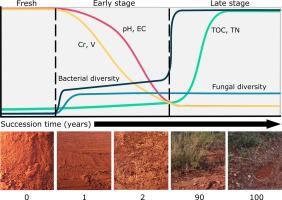Journal of Hazardous Materials ( IF 12.2 ) Pub Date : 2021-10-11 , DOI: 10.1016/j.jhazmat.2021.127470 Luis Alberto Macías-Pérez 1 , Clément Levard 2 , Mohamed Barakat 3 , Bernard Angeletti 2 , Daniel Borschneck 2 , Laurent Poizat 4 , Wafa Achouak 3 , Mélanie Auffan 5

|
Bauxite residue is the alkaline byproduct generated during alumina extraction and is commonly landfilled in open-air deposits. The growth in global alumina production have raised environmental concerns about these deposits since no large-scale reuses exist to date. Microbial-driven techniques including bioremediation and critical metal bio-recovery are now considered sustainable and cost-effective methods to revalorize bauxite residues. However, the establishment of microbial communities and their active role in these strategies are still poorly understood. We thus determined the geochemical composition of different bauxite residues produced in southern France and explored the development of bacterial and fungal communities using Illumina high-throughput sequencing. Physicochemical parameters were influenced differently by the deposit age and the bauxite origin. Taxonomical analysis revealed an early-stage microbial community dominated by haloalkaliphilic microorganisms and strongly influenced by chemical gradients. Microbial richness, diversity and network complexity increased significantly with the deposit age, reaching an equilibrium community composition similar to typical soils after decades of natural weathering. Our results suggested that salinity, pH, and toxic metals affected the bacterial community structure, while fungal community composition showed no clear correlations with chemical variations.
中文翻译:

以复杂的地球化学环境为标志的铝土矿残渣矿床的对比微生物群落定殖
铝土矿渣是氧化铝提取过程中产生的碱性副产品,通常填埋在露天矿床中。由于迄今为止还没有大规模的再利用,全球氧化铝产量的增长引发了对这些矿床的环境问题。包括生物修复和关键金属生物回收在内的微生物驱动技术现在被认为是重新评估铝土矿残渣价值的可持续且具有成本效益的方法。然而,微生物群落的建立及其在这些策略中的积极作用仍然知之甚少。因此,我们确定了法国南部生产的不同铝土矿残留物的地球化学成分,并使用 Illumina 高通量测序探索了细菌和真菌群落的发展。物理化学参数受矿床年龄和铝土矿来源的不同影响。分类学分析揭示了一个早期的微生物群落,以嗜卤碱微生物为主,并受到化学梯度的强烈影响。微生物丰富度、多样性和网络复杂性随着沉积年龄而显着增加,经过数十年的自然风化,达到类似于典型土壤的平衡群落组成。我们的研究结果表明,盐度、pH 和有毒金属会影响细菌群落结构,而真菌群落组成与化学变化没有明显的相关性。随着沉积年龄的增长,多样性和网络复杂性显着增加,经过数十年的自然风化,达到了与典型土壤相似的平衡群落组成。我们的研究结果表明,盐度、pH 和有毒金属会影响细菌群落结构,而真菌群落组成与化学变化没有明显的相关性。随着沉积年龄的增长,多样性和网络复杂性显着增加,经过数十年的自然风化,达到了与典型土壤相似的平衡群落组成。我们的研究结果表明,盐度、pH 和有毒金属会影响细菌群落结构,而真菌群落组成与化学变化没有明显的相关性。











































 京公网安备 11010802027423号
京公网安备 11010802027423号